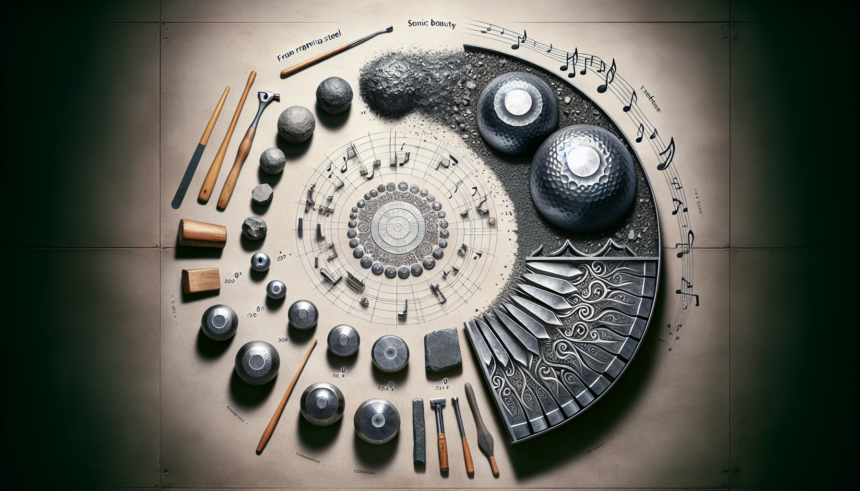From Raw Steel to Sonic Beauty: The Handpan Tuning Journey
The handpan, with its ethereal and resonating tones, holds a special place in the world of musical instruments. Creating the handpan is indeed an art and a science, each step contributing to the final masterpiece. This article takes you through the intricate journey from raw steel to a beautifully tuned handpan, explaining every critical aspect and craftsmanship involved in its creation.
The Beginning: Selecting the Steel
The journey begins with the careful selection of raw steel. The quality of the steel is paramount as it significantly influences the sound quality and durability of the handpan. Most handpans are made from nitrided steel or stainless steel. Nitrided steel is preferred for its enhanced resistance to rust and optimal acoustic properties. Stainless steel, on the other hand, offers a brighter and longer-lasting metallic resonance.
Forming the Shells
Once the appropriate steel is selected, the next stage involves forming the shells. This is usually done by spinning or pressing the steel into a hemispherical shape. The thickness of the steel shell is meticulously controlled to ensure uniformity, which is crucial for the sound balance of the final instrument. The raw shells are then polished to remove any marks or imperfections before moving on to the heat treatment phase.
Heat Treatment: Toughening the Steel
The formed shells are subjected to heat treatment, a process known as “nitriding.” This involves heating the shells in a controlled environment saturated with nitrogen. The nitrogen atoms penetrate the steel surface, increasing its hardness and resistance to corrosion. This step is vital as it not only enhances the durability of the instrument but also improves its tonal qualities.
Initial Grooving and Shaping
After heat treatment, the shells are prepared for initial grooving and shaping. This stage involves marking out the notes and creating initial impressions in the steel. Skilled artisans map out the positions of the notes meticulously, considering factors like spacing and size for optimal sound production. Each note is then hammered and shaped to form initial grooves, preparing the shells for the detailed tuning process.
Tuning: The Heart of Handpan Craftsmanship
The tuning process is the most intricate and crucial part of the handpan creation journey. It requires immense skill, patience, and a deep understanding of acoustics. The tuning is done by hand, where each note area is hammered meticulously to achieve the desired pitch, overtones, and sustain. Tuners often use tuning forks, electronic tuners, and their keen auditory skills to refine each note.
Each note on a handpan typically has three specific frequencies: the fundamental tone, the octave, and the compound fifth. The fundamental tone is the primary pitch, while the octave and fifth create harmonic overtones, enriching the overall sound. The tuner’s goal is to ensure all these frequencies are perfectly aligned, creating harmony across the entire instrument.
Fine-Tuning: Achieving Acoustic Perfection
Once the initial tuning is complete, the handpan undergoes a series of fine-tuning sessions. This process is iterative, where the tuner repeatedly fine-tunes each note, allowing time for the steel to settle between sessions. Fine-tuning ensures that the handpan maintains its tonal quality over time and under different playing conditions.
Fine-tuning can also involve adjusting the sustain and volume of each note. Some notes may require slight adjustments in their shaping to achieve the perfect balance. Experienced tuners often rely on their intimate knowledge of the steel’s behavior, acquired through years of practice, to make these subtle calibrations.
Finishing: Adding the Final Touches
After achieving the desired tuning, the handpan enters the finishing stages. This includes cleaning, polishing, and often adding protective coatings. The goal is to enhance the instrument’s appearance and longevity. Protective coatings not only provide a glossy finish but also help in preventing rust and other environmental damages.
During the finishing process, some makers also inscribe their logos or unique designs on the handpan, adding a personal touch reflecting their brand and craftsmanship.
Quality Check: Ensuring Perfection
Before the handpan is deemed ready, it undergoes rigorous quality checks. Each note is carefully examined for pitch accuracy, tonal quality, and sustain. Experienced players might also test the handpan to ensure it meets the highest standards of musicality. Any discrepancies found are addressed with additional tuning and adjustments.
Conclusion
The journey from raw steel to a beautifully tuned handpan is a testament to the blend of art, science, and dedication. Each step, from selecting the steel to the final finishing touches, requires careful attention and skilled craftsmanship. The result is an instrument that not only looks beautiful but also produces a mesmerizing array of sounds, capable of captivating listeners and players alike. The handpan stands as a symbol of precision, passion, and the relentless pursuit of acoustic excellence, truly making it a sonic beauty born from raw steel.
FAQs
-
Q: What materials are commonly used to make handpans?
A: Handpans are typically made from nitrided steel or stainless steel, chosen for their acoustic properties and durability.
-
Q: How long does it take to make a handpan?
A: The creation of a handpan can take several weeks to months, depending on the complexity of the tuning and finishing processes.
-
Q: Can the tuning of a handpan change over time?
A: Yes, the tuning can change due to factors like temperature, humidity, and frequent playing. Regular maintenance and retuning by a skilled tuner can help maintain its optimal sound.
-
Q: How many notes can a handpan have?
A: A typical handpan features 7 to 9 notes arranged around a central note, but the number can vary based on the design and maker.
-
Q: What makes handpans so expensive?
A: The cost of handpans reflects the intricate craftsmanship, extensive labor, high-quality materials, and the skill required for precise tuning and finishing.





